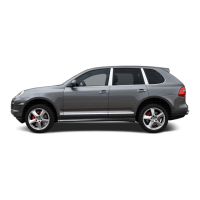Driving and Driving Safety 179
Starting and Stopping the Engine
f The immobilizer can be deactivated and the
engine started only using an authorized
ignition key. For further information on the
immobilizer:
Please observe the chapter “IMMOBILIZER” on
Page 273.
f For further information on the emission control
system:
Please observe the chapter “EMISSION
CONTROL SYSTEM” on Page 290.
Danger!
Risk of poisoning. Exhaust gas contains
colorless and odorless carbon monoxide
(CO), which is toxic even in low concentrati-
on. Carbon monoxide can cause uncons-
ciousness and even death if inhaled.
f Never start or let the engine run in an enc-
losed, unventilated area. It is not recommen-
ded to sit in your car for prolonged periods
with the engine on and the car not moving.
An unattended vehicle with a running engine
is potentially hazardous. If warning lights
should come on to indicate improper opera-
tion, they would go unnoticed.
f Never leave the engine idling unattended.
Danger of fire in the area of the hot exhaust
system.
f Do not drive or park your car where combus-
tible materials, such as dry grass or leaves,
can come into contact with the hot exhaust
system.
f If your car catches on fire for any reason, call
the fire department. Do not endanger your life
by attempting to put out the fire.
Starting the vehicle
f Operate footbrake.
f Move Tiptronic selector lever to position
P or N.
f Do not press the accelerator pedal.
The engine control module will provide the
correct starting mixture.
f Turn ignition key to ignition lock position 2.
f Do not operate the starter longer than
approx. 10 seconds.
If necessary, repeat the starting procedure
after a pause of approx. 10 seconds. Turn the
ignition key back to ignition lock position 3
first.
The first operation of the starter is ended
automatically when the engine starts.
If the engine does not start, subsequent starter
operations will not be ended automatically.
f Do not warm up the engine when stationary.
Drive off immediately.
Avoid high revolutions and full throttle until the
engine has reached operating temperature.
f If battery output is insufficient, jump leads can
be used to start the engine.
Please observe the chapter “EMERGENCY
STARTING WITH JUMPER CABLES” on
Page 361.

